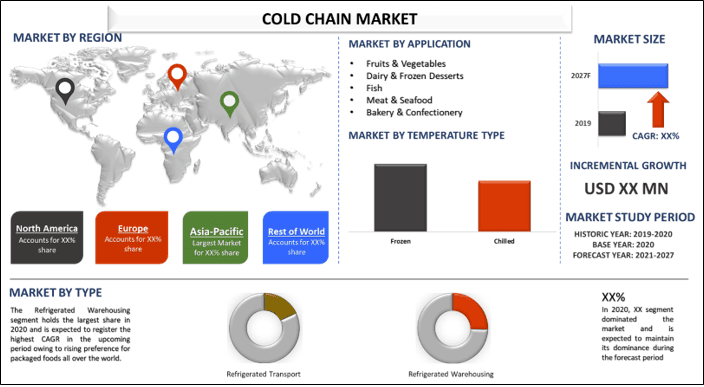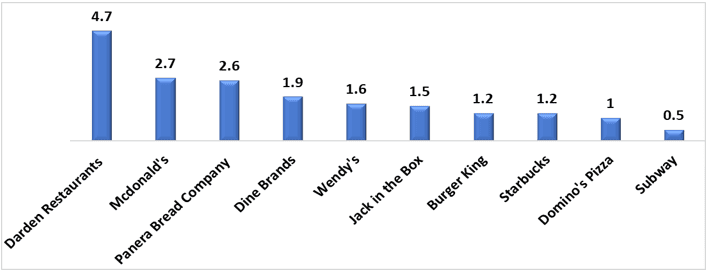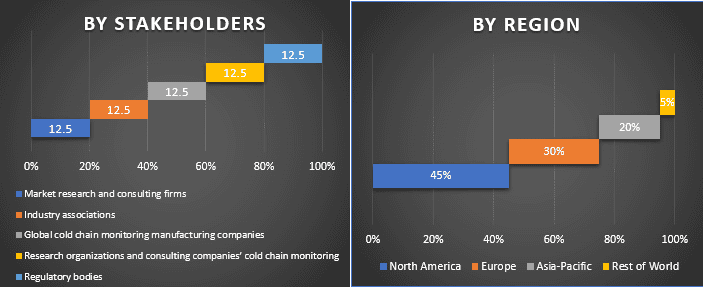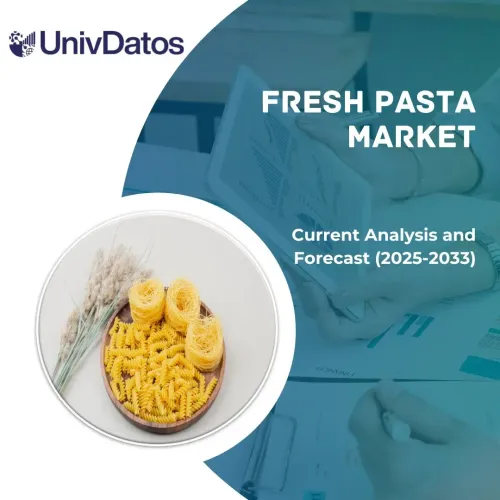- Home
- About Us
- Industry
- Services
- Reading
- Contact Us
Cold Chain Market: Current Analysis and Forecast (2021-2027)
Emphasis on Application (Fruits & Vegetables, Dairy & Frozen Desserts, Fish, Meat & Seafood, Bakery & Confectionery); Temperature Type (Frozen, Chilled); Type (Refrigerated Transport, Refrigerated Warehousing); Region/Country
 The cold chain market is expected to grow at a CAGR of ~8% over the forecast period (2021-2027). Cold Chain is a mixture of temperature-controlled surface transport and supply chain. It relates to the freezing solutions which help to maintain the quality and shelf life of products, for example, seafood, agricultural produce, frozen food, chemicals, photographic film, and pharmaceutical drugs. Nowadays, Cold chains are necessary for extending the period of marketing, decreasing transport bottlenecks during peak periods, and preventing overcapacity. The process comprises the exploitation of temperature-monitored warehouses for the storage and cold insulated transport vehicles for the distribution of products. Cold chain logistics solutions are extensively employed for the transportation and storage of vegetables, fruits, beef, meat, drugs, and medicines. In addition, various transportation modes such as refrigerated railcars, refrigerated trucks, air cargo, refrigerated cargo are also used.
The cold chain market is expected to grow at a CAGR of ~8% over the forecast period (2021-2027). Cold Chain is a mixture of temperature-controlled surface transport and supply chain. It relates to the freezing solutions which help to maintain the quality and shelf life of products, for example, seafood, agricultural produce, frozen food, chemicals, photographic film, and pharmaceutical drugs. Nowadays, Cold chains are necessary for extending the period of marketing, decreasing transport bottlenecks during peak periods, and preventing overcapacity. The process comprises the exploitation of temperature-monitored warehouses for the storage and cold insulated transport vehicles for the distribution of products. Cold chain logistics solutions are extensively employed for the transportation and storage of vegetables, fruits, beef, meat, drugs, and medicines. In addition, various transportation modes such as refrigerated railcars, refrigerated trucks, air cargo, refrigerated cargo are also used.
Sales of the Leading Quick Service Restaurants in US 2017, Per Store (in US$ Mn)

Insights Presented in the Report
“Amongst Application, Dairy & Frozen Desserts segment dominated the market in 2020.”
Based on Application, the market is fragmented into Fruits & Vegetables, Dairy & Frozen Desserts, Fish, Meat & Seafood, and Bakery & Confectionery. The Dairy & Frozen Desserts segment dominated the market in 2020 and is expected to grow at lucrative during the forecasted period. The dairy & frozen dessert segment represents the largest part of the cold chain market. Dairy products such as Milk have been related to foodborne illnesses for centuries. According to the Centers for Disease Control and Prevention, 48 million people get sick, 128,000 get hospitalized and 3,000 people die from food-borne illness each year in the United States. Dairy Products are one of the most regulated foods. Cold chain logistics are important for the maintenance of the dairy products’ quality. The cold chain makes certain that low temperature is preserved, as required by dairy products, throughout the supply chain.
“Amongst Temperature Type, Frozen segment holds the major share.”
Based on Temperature Type, the market is bifurcated into Frozen and Chilled. The Frozen segment dominated the market in 2020 and is expected to grow at lucrative during the forecasted period. The freezing of food the preservation of the storage life of food products by making them more inert. In addition, the freezing process slows down the biological and chemical reactions that encourage food spoilage and limit the shelf-life. Frozen products have a standard temperature range between 18°C and -25°C. Freezing preserves the texture, taste, and nutritional value of the food products. Though, it also depends upon the type of food materials, the use of pre-treatments, the choice of freezer & frozen storage options, and the usage of appropriate packaging
“Amongst Type, the Refrigerated Warehousing segment is anticipated to witness highest CAGR growth.”
Based on Type, the market is bifurcated into Refrigerated Transport and Refrigerated Warehousing. The Refrigerated Warehousing segment holds the largest share in 2020 and is expected to register the highest CAGR in the upcoming period owing to rising preference for packaged foods all over the world. The Shifting of dietary patterns and lifestyles of consumers is further driving the demand for frozen foods which in turn boosts the demand for warehousing. According to the GCCA, the total capacity of refrigerated warehouses all over the world was 616 million cubic meters in 2018, 2.67% greater than the capacity reported in 2016.
“North America signifies one of the largest markets.”
For a better understanding of the market adoption of Cold Chain, the market is analyzed based on its worldwide presence in the countries such as North America (United States, Canada, and the Rest of North America), Europe (Germany, France, Spain, United Kingdom and Rest of Europe), Asia-Pacific (China, Japan, India, Australia, and Rest of APAC), and Rest of World. Asia-Pacific will dominate the Cold Chain market on account of the rising economic developments of countries such as China, India, Japan, and Australia. The shift of industrialization and investments in the Asia Pacific has grown substantially over the past decade, especially in China and India, contributing to rapid economic growth. Moreover, the high demand for dairy and meat products in the Asia Pacific region is leading to the high demand for the preservation of quality and nutritive elements in the products, which drives the market for cold chains in the region. Some of the major players operating in the market include Americold Logistics, Lineage Logistics Holdings, Nichirei Corporation, Burris Logistics, Agro Merchants Group, Kloosterboer, United States Cold Storage, Tippmann Group, VersaCold Logistics Services, and Henningsen Cold Storage Co. Several M&As along with partnerships have been undertaken by these players to boost their presence in different regions.
Reasons to buy this report:
- The study includes market sizing and forecasting analysis validated by authenticated key industry experts
- The report presents a quick review of overall industry performance at one glance
- The report covers an in-depth analysis of prominent industry peers with a primary focus on key business financials, product portfolio, expansion strategies, and recent developments
- Detailed examination of drivers, restraints, key trends, and opportunities prevailing in the industry
- The study comprehensively covers the market across different segments
- Deep dive regional level analysis of the industry
Customization Options:
The Cold Chain market can further be customized as per the requirement or any other market segment. Besides this, UMI understands that you may have your own business needs, hence feel free to connect with us to get a report that completely suits your requirements.
Table of Content
Analyzing the historical market, estimation of the current market, and forecasting the future market of the Global Cold Chain market were the three major steps undertaken to create and analyze the adoption of Cold Chain for the different applications. Exhaustive secondary research was conducted to collect the historical market numbers and estimate the current market size. Secondly, to validate these insights, numerous findings and assumptions were taken into consideration. Moreover, exhaustive primary interviews were also conducted, with industry experts across the value chain of the Cold Chain sector. Post assumption and validation of market numbers through primary interviews, we employed a bottom-up approach to forecasting the complete market size. Thereafter, market breakdown and data triangulation methods were adopted to estimate and analyze the market size of segments and sub-segments the industry pertains to. Detailed methodology is explained below:
Analysis of Historical Market Size
Step 1: In-Depth Study of Secondary Sources:
The detailed secondary study was conducted to obtain the historical market size of the Cold Chain through company internal sources such as annual reports & financial statements, performance presentations, press releases, etc., and external sources including journals, news & articles, government publications, competitor publications, sector reports, third-party database, and other credible publications.
Step 2: Market Segmentation:
After obtaining the historical market size of the Cold Chain market, we conducted a detailed secondary analysis to gather historical market insights and share for different segments for major regions. Major segments included in the report are application, temperature type, type, and region. Further country-level analyses were conducted to evaluate the overall adoption of Cold Chain in every region.
Step 3: Factor Analysis:
After acquiring the historical market size of different segments and sub-segments, we conducted a detailed factor analysis to estimate the current market size of Cold Chain. Further, we conducted factor analysis using dependent and independent variables such as increasing need for temperature control to prevent food losses, growth in international trade owing to trade liberalization. Demand and supply side analysis was also conducted.
Current Market Size Estimate & Forecast
Current Market Sizing: Based on actionable insights from the above 3 steps, we arrived at the current market size, key players in the Cold Chain Market, and market shares of the segments. All the required percentage shares split, and market breakdowns were determined using the above-mentioned secondary approach and were verified through primary interviews.
Estimation & Forecasting: For market estimation and forecast, weights were assigned to different factors including drivers & trends, restraints, and opportunities available for the stakeholders. After analyzing these factors, relevant forecasting techniques i.e., bottom-up approach was applied to arrive at the market forecast about 2027 for different segments and subsegments across the major markets globally. The research methodology adopted to estimate the market size encompasses:
- The industry’s market size, in terms of value (USD) and the adoption rate of Cold Chain across the major markets domestically
- All percentage shares, splits, and breakdowns of market segments and sub-segments
- Key players in the Cold Chain market in terms of services offered. Also, the growth strategies adopted by these players to compete in the fast-growing market.
Market Size and Share Validation
Primary Research: In-depth interviews were conducted with the Key Opinion Leaders (KOLs) including Top Level Executives (CXO/VPs, Sales Head, Marketing Head, Operational Head, and Regional Head, Country Head, etc.) across major regions. Primary research findings were then summarized, and statistical analysis was performed to prove the stated hypothesis. Inputs from primary research were consolidated with secondary findings, hence turning information into actionable insights.
Split of Primary Participants in Different Regions

Market Engineering
Data triangulation technique was employed to complete the overall market estimation and to arrive at precise statistical numbers of each segment and sub-segment of the Cold Chain market. Data was split into several segments & sub-segments post studying various parameters and trends in the areas of Application, Temperature Type, Type, and Region of the Cold Chain market.
Main Objective of the Cold Chain Market Study
The current & future market trends of Cold Chain were pinpointed in the study. Investors can gain strategic insights to base their discretion for investments from the qualitative and quantitative analysis performed in the study. Current and future market trends were determined the overall attractiveness of the market at a regional level, providing a platform for the industrial participant to exploit the untapped market to benefit as a first-mover advantage. Other quantitative goals of the studies include:
- Analyze the current and forecast market size of Cold Chain in terms of value (USD). Also, analyze the current and forecast market size of different segments and sub-segments.
- Segments in the study include areas of Application, Temperature Type, Type, and Region
- Define and analysis of the regulatory framework for the Cold Chain industry
- Analyze the value chain involved with the presence of various intermediaries, along with analyzing customer and competitor behaviors of the industry
- Analyze the current and forecast market size of the Cold Chain market for the major region
- Major regions studied in the report include North America (the United States and Canada), Europe (Germany, France, Spain, and United Kingdom), Asia-Pacific (China, Japan, India, and Australia), and the Rest of the World
- Company profiles of the Cold Chain market and the growth strategies adopted by the market players to sustain in the fast-growing market
- Deep dive regional level analysis of the industry
Related Reports
Customers who bought this item also bought










